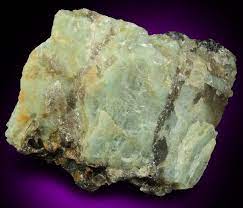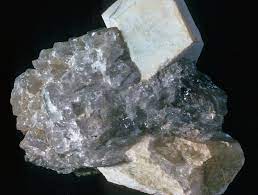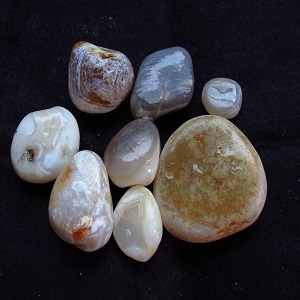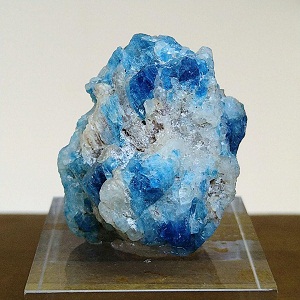Oligoclase (in English: Oligoclase)

With the chemical formula (NaCa) [Al 1-2 Si 3-2 O8], it is a mineral group and is derived from the word oligos. Color the flame green – insoluble in acids Various mixtures of albite to anorthite
In terms of crystal shape: prismatic – disc-shaped – macle
Color: black – black gray – blue – pearl – red
Transparency: transparent-semi-opaque, fracture: irregular
Polished: glassy – shell, surface: perfect – matching the surface
Crystallization system: It is triclinic and classified as silicate, it also has no magnetic properties and its origin is magmatic-pegmatite

General information
Classification of silicates
chemical formula
(repetitive part) (NaCa) [Al 1-2 Si 3-2 O8]
Attributes
Color black – black gray – blue – pearl – red
Full stroke – conforming to the surface
Irregular fracture
Mouse hardness 6.5-6
Glass polish – shell
Black outline color
Clear transparency – semi-opaque
The appearance characteristics of crystal – granular aggregate – mass is rare and mostly in Norway, Italy and Russia
Synergy of hardness – density – dissolution in acids – X-ray – optical properties – chemical reactions of amblygonite – scapolite – gelenite – mililite – orthose – sanidine – microcline – muscovite – biotite – orthose – quartz
Further explanation Color the flame green – insoluble in acids Various mixtures of albite to anorthite
The reason for the name is derived from the word oligos
Magmatic-pegmatite origin
Its mineralogy (parange) is hardness – density – dissolution in acids – X-ray – optical properties – chemical reactions amblygonite – scapolite – gelenite – mililite – orthose – sanidine – microcline – muscovite – biotite – orthose – quartz, according to Zisman crystal Granular aggregate is a rare mass and is mostly found in Norway, Italy and Russia

Qamar stone is the most famous type of orthoclase feldspar, i.e. potassium aluminum silicate. This transparent to opaque oligoclase rock is a variety of plagioclase elbite and sheet mica
Moonstone has a remarkable shine under certain light conditions, and this shine is the reason for the popularity of this gemstone today
In fact, the name of this stone is derived from its dazzling blue glow that resembles the moon. Gemologists call this brilliant visual phenomenon “milky glow”
The visual phenomenon of the milky glow is obtained as a result of the special structural pattern of moonstone
Small grains of elbite, sodium aluminum silicate are combined in layers of host rock of orthoclase, potassium aluminum silicate
The variable layers of different feldspars form a layered (uneven) structure that interferes with the incoming light
Thin layers of variable silicate return a more colorful and attractive shine, and on the contrary, thick layers of silicate create a white to colorless and less attractive shine
When the light enters the stone, it is refracted and diffused, which results in a beautiful phenomenon of light and a beautiful and special color
In the moonstone, the light radiation shines deeper than the surface of the stone
The famous oligoclase stone
Qamar stone achieved high fame during the period of “new art”, that is, about 100 years ago
At that time, this stone was used in the decoration of stone jewelry by the famous French master goldsmith, René Lalique and his colleagues
His rare pieces can often be found in museums or private collections
Identification of oligoclase rock

Moonstone is recognizable by its milky glow
Other stones with a similar appearance do not have a milky glow phenomenon, and in this way the moonstone is easily identified
Moonstone is potassium aluminum silicate and is easily identified by its composition
Many similar materials such as labradorite are actually plagioclase feldspar, while moonstone is a potassium feldspar in terms of its structural composition
Hardness measurement is one of the easiest ways to distinguish moonstone from other materials
Other similar gemstones such as opal, ymanite or ammolite are noticeably softer or harder than moonstone
High quality moonstone has a “three-dimensional” color depth that is not seen in other gemstones, which makes it easier to recognize moonstone
Origin and resources of oligoclase rock
Moonstone deposits are often found as major components of feldspar-rich shale and coarse shale throughout the world
The most important deposits of moonstone are located in Sri Lanka and India
Other notable sources are in Australia, Brazil, Germany, India, Myanmar (Burma), Madagascar, Mexico, Norway, Switzerland, Tanzania, and the United States
Sri Lankan moonstone is famous for its beautiful blue material, but blue moonstone is becoming increasingly rare
India is also famous for its “rainbow moonstone”
Switzerland’s Adola mountains have the most interesting historical mines of moonstone
Buying and determining the value of oligoclase stone
Oligoclase rock color
Moonstone is usually colorless but can be found in a wide range of colors from gray, mocha brown, yellow, orange, green, pink, blue and white
This stone can be seen white to blue-white, but other sparkles can be seen in silver and blue-orange colors
Sri Lankan moonstones are among the most valuable with a pale blue glow on their almost transparent body
Indian moonstone has cloud-like lights in beige, green, orange or simple brown colors, which are very valuable
Rarer colors are blue, peach, smoky, champagne, black and red
Clarity and brilliance of oligoclase stone
Moonstone is often seen with crystal clear clarity
Clear species are usually uncommon but not non-existent
The transparent moonstone is known as the most valuable species
Moonstone after
Cutting and polishing has an attractive glassy to pearly luster
Some moonstones have variable brightness
In the business world, these types of stones are called “cat’s eye moonstone”
Other rare types of moonstone have star markings
This is called “stellar moonstone”. Star Moonstone and Cat’s Eye are extremely rare and popular
Cutting and shape of oligoclase rock
Moonstone is almost always cut into cabochons because of its milky luster
The direction of cutting in red stone is very important
The proper weight of the stone is important when reflecting the top light, and for this reason, most moonstones are cut in a dome shape
The cutters must place the crystal axis exactly at the top of the stone to achieve the correct direction, and in this way, Schiller’s works are maximized
Moonstone is usually cut in an oval shape because oval shapes hold the most carat weight
Some clear stones may be chamfered, but chamfered moonstone is very rare
Oligoclase stone processing
Moonstone is usually not processed in any way, but there have been reports of blue moonstone color enhancement coatings
Gemological properties of oligoclase stone
Oligoclase
Chemical formula: KalSi3O8 potassium aluminum silicate
Crystal structure: chilipai crystal, prismatic
Color: colorless, yellow, brown, orange, pale luster
Hardness: 6 to 6.5 on the mouse scale
Refractive index: 1.518 to 1.526
Density: 2.56 to 2.59
Cleavage: Excellent
Transparency: Transparent to translucent
Double refraction or refraction of light: -0.008
Luster: vitreous to pearlescent
Fluorescence: weak, blue, orange
Gemstones similar to and related to oligoclase
Moonstone belongs to the large group of feldspar minerals, the most abundant minerals on the planet
Feldspars make up about 60% of the Earth’s crust, which means that gemstones and moonstone-related minerals are abundant
Quartz gemstones are the second most abundant gemstone group after feldspar
Feldspars are usually divided into two main groups of gemstones, potassium feldspar and plagioclase feldspar
All types of moonstone are potassium feldspar
Other potassium feldspar gemstones include amazonite and orthoclase
There are also gemstones such as “Rainbow Moonstone” that look very similar to moonstone
Rainbow moonstone is actually not a moonstone and is a type of labradorite plagioclase feldspar
For this reason, it is sometimes referred to as “Labradorite with blue shimmer”
Most famous gemstones and related or similar brand names
Star Moonstone, Cat’s Eye Moonstone, Rainbow Moonstone, and Sunstone are some of the most popular brand names used for related or similar gemstones
Lesser known brand names and gemstones
Orthoclase, amazonite, labradorite, andesine, andesine-labradorite, and oligoclase are lesser-known trade names for related or similar gemstones




